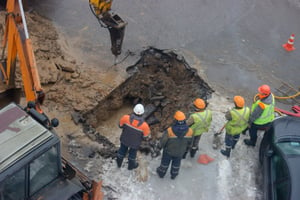Many wastewater pros focus exclusively on gathering inspection footage, but that task is only a small part of the wastewater assessment workflow. And throughout the inspection process, there are a lot of handoffs: from supervisors who are assigning work to inspection crews; from crews who take videos and record observations to the teams assessing and prioritizing future work; from contractors to municipalities when work is completed; and more. Not surprisingly, crews that can transfer inspection and rehab information smoothly tend to work more quickly and efficiently.

Why Communication Matters
The research is clear: More communication offers benefits across the organization. On average, employees in organizations that enable effective internal communication are 20 to 25% more productive. If inspection data can immediately be transferred from the field to clients and coding teams, everyone can turn work around faster. Communication also creates happier employees who are more likely to stick around. One study found that businesses with effective communication practices were more than 50% more likely to report below-average employee turnover levels. In the wastewater industry, where sewer pros bring increasingly specialized skills to their jobs and a large segment of the workforce is rapidly nearing retirement age, employee retention is a priority. No one likes waiting around for others in the workflow to wrap up a project, or seeing the results of a hard day out in the field get lost in the shuffle.
How Wastewater System Operators Can Improve Collaboration
It may not always be easy, but wastewater professionals have an arsenal of tools at their command to improve communication and collaboration between teams and between internal workers and contractors. Here’s how to get started:
- Assess your current communications and collaboration. How well do your teams communicate currently, and what are the roadblocks they face? Are there specific bottlenecks in project assignments, work orders, or data management that regularly slow you down?
- Keep it simple. When workers are spread across field and office locations, clarity is essential. Setting clear, easy standards for everything from data transfers to equipment repairs can help keep everyone on track.
- Make communication an ongoing conversation. Keep everyone informed—whether you’re buying new equipment, onboarding new hires, or scheduling new projects. When everyone involved in the work knows what’s happening and what their role in the larger operation of wastewater management is, they do better work.

Answers in Technology
More and more municipalities are finding that technology can help them share and communicate better, and thus accelerate inspection workflows substantially. Most significantly, software that is tailor-made for the wastewater industry can help manage data, coordinate crews, map inspection results and prioritize projects. WinCan Web, for example, was built for O&M data specific to wastewater infrastructure and has its own support for processes, workflows and collaboration. The software that comes built in Envirosight cameras, it helps operators collect exactly the information that coders and managers need. And since it’s based in the cloud, it supports immediate data updates and easy, secure sharing—and no crews are left unloading inspection footage at the end of the week. Cloud-based workflows also ensure that there’s a single version of the truth that always reflects the most up-to-date version of inspection data and project status. Everyone has the same information, at the same time.
WinCan also syncs seamlessly with asset management systems like CentralSquare, Cityworks and Cartegraph to inventory, map, analyze, budget and manage maintenance of their municipal assets. Precise wastewater data in WinCan can feed automated workflows for work orders and notifications to connect people, functions and systems across the organization as well as with external partners, like contractors and engineers. In doing so, communities create opportunities for greater visibility and collaboration within a municipality as a whole.
Communication across wastewater inspection, management and rehab doesn’t have to be a pain point. With a few key strategies that focus both on people and on automated digital workflows and the cloud-based solutions that enable them, system operators can help teams work more efficiently and collaboratively.
Ready to improve communication and collaboration across your team with the wastewater inspection industry's most powerful cloud-based platform? Schedule a demo of WinCan Web with one of our experts.

